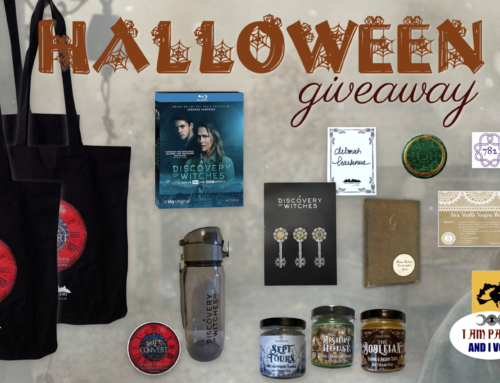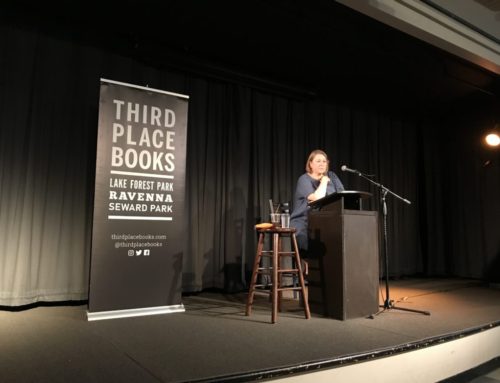In addition to A Discovery Of Witches, Wales has been the backdrop for Doctor Who, Sherlock, Harry Potter, and many more TV and movie hits. Gareth Skelding—a.k.a. Gaz—is the location manager for A Discovery Of Witches, and is known for his work on Sherlock, Da Vinci’s Demons, Torchwood and Dr. Who. After you read what Gaz has to say about Wales, you will want to pack your bags and visit this enchanting land. Whether you call it “location scouting” (American English) or “recce” (British English), as a location manager, Gaz is a Wales expert and treasure hunter, and Wales could not ask a better advocate.
[By Aedrey G. & Laura V.]
The Tenth Knot: Hello Gaz. It’s great to meet you!
Gaz: We say in Welsh, “Prynhawn Da.” That means “good afternoon” in Welsh. Deborah’s an old hand at Welsh now, she’s a bit of a Welsh speaker, we’ve been teaching her. You fire away.
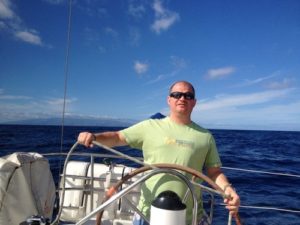
The Tenth Knot: Gaz, how did you get into location management to begin with?
Gaz: Television runs in my family. My dad is a first assistant director, so I sort of fell into that world maybe—it’s making me sound so old now—but probably 20 years ago now. I was about 20 years old and started as a production runner: picking up the actors in the morning, delivering the tea and coffee, etc.
I used to play rugby and through sports I got to travel and see all these funny little nooks, avenues, mountains and funny villages all tucked away in Wales. I have a bit of an eye for a shot and remembered all these weird little places. I went from assistant director into locations and that was it. I owe my knowledge of Wales to rugby, standing there in the middle of the wind and the rain, or on top of a mountain in the top end of a weird valley. I remembered all the cool caves that were there, steel works, mines and all these different things that Wales had to offer.
We’ve got 363 odd castles in Wales
The Tenth Knot: That’s wonderful. The world of All Souls is very visually rich and Deborah Harkness has shared the locations that inspired the All Souls trilogy even before The World of All Souls, the fourth book, was published. What kind of homework did you do to find all the different locations?
Gaz: Well, James North, our very talented production designer, created a world with Deborah that very quickly established the look of locations that Deborah had in her mind’s eye. James would present me that portfolio and I would come up with ideas, what would be close in Wales or just over the bridge in southwest England—Gloucestershire. We’d shot this mainly in our studios in Cardiff, as you know, a lot of these locations are within an hour’s drive from Cardiff. The lucky thing is that Cardiff offers us so much because of our heritage. We’ve got 363 odd castles in Wales—we’re not short on castles—so we have many, many to choose from. James put the visual book together very fast with Deborah, then the production team would hone in on where we should really concentrate on bringing alive or what we can get away with using CGI (computed-generate imagery) to make them feel as close as we could to Deborah’s vision.
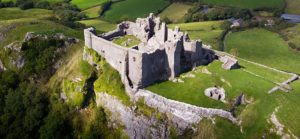
The Tenth Knot: How closely did the locations you suggested along with the visuals James North proposed align with Deborah’s vision? Was using the exact locations Deborah was inspired by ever a possibility?
Gaz: Yes and no. When we were trying to match up locations, it was obviously an interesting challenge trying to keep locations in Wales. We could do some of it and we would put all our eggs in a basket and really go after that set and really make that set look amazing and beautiful as we possibly can. There would be other things that were less important to the story… But we have free reign with Deborah and James, so we’d suggest alternatives and put different twists on a location and see if that worked, which it did. We’d queue up suggestions, ‘What if we went this way?’, put some twist on it and Deborah was very happy to let us run with those things.
The Tenth Knot: That makes perfect sense. And how many locations do you typically scout for scene? How do you come up with the list of possible locations or places to visit?
Gaz: For the moment, we’d ignore the books and would come with pages adapted by Kate Brooks into the script. We always use that script as a guide. We’ll get a script and James North and I, the director, the producer, maybe the showrunner Kate Brooks or Jane Tranter might become involved. We would send them ideas, read through those scripts and just chat through each scene, and between us just bounce some ideas of what we think this would entail, what is important about the scene and what we’re trying to get through from the point of location. ‘Is it too complicated to be on location?’, ‘Do we do too many special effects, with lots of fire?’, that sort of thing. At that point we decide maybe, we should be looking at James building a set. We’ll always sit down and decide what the important things are to achieve, what visual rewards we want to get from that and provide people. And then I’ll put my view across saying, ‘I think this is too much for me to find,’ ‘Or we’ll give you this location but we’ll only give it to you for a day,’ and probably cut more material then a day’s work. Very early on, we’ll balance out what we think we’re looking for and what will be a set and try to decide from there, where we go from that point.
The Tenth Knot: From the time when you compile that list or when you discuss an idea, how far in advance do you scout those locations? Or is that done before you pitch ideas?
Gaz: It’s very, very dependent on when we get the script. Usually we like to get a script six to eight weeks before we shoot something, or we start filming a block and that gives me time to get out for a week or two and scout the location, and show the director and the producer and James. We’ll get out and show them some various locations. Typically, I like to sort of get two or three options of a location for each set and then we’ll go get visuals.
Hopefully, we have a six-week run until the shoot day which gives James the chance to plan it out with his team and gives me the chance to speak to location owners or very often a lot of the heritage staff in Wales. I then need to deal with them and discuss how we approach it, what we can and can’t do, what parts of the building are protected, what we need to avoid, all those funny complicated questions.
Then of course we put together the bigger plan for the safety layer. We’re putting a 150-capacity crew into this location and taking them away safely at the end of the day. So that’s quite a big part, we have the safety part of it. We ask, ‘Can we pull it off? Can we get everyone involved so they’re family?’ That’s a very important part of it to me.
The Tenth Knot: That’s a huge endeavor. How large is your team?
Gaz: In the location scene, I would probably have about eight people. Three or four people who work ahead, setting it up with me and three or four people on the floor ‘babysitting’—for lack of a better word—making sure things flow as they should.
We then work together as a team
The Tenth Knot: When you have more than one location, multiple options, how do you choose the perfect one, apart from practical concerns like budget and weather and things like that?
Gaz: There are so many variables. The visuals, the availability, the scheduling, the availability of cast, they might want to shoot the castle on Monday—Tuesday, do the job Friday. There are so many different things. Any of that can really complicate the jigsaw puzzle. It’s not just my choice. James might not be able to get it ready or painted on crafts. On Thursday, he might have his own problems. Usually, we have ways of making it work but there are times when we will have to go for the second-best choice of locations because of some issue with the first choice.
So that happens quite often but it’s a team decision. A competent director will really want the location from you … and we’ll do our very best to deliver it, but sometimes it’s just not possible. We then work together as a team to come up with special alternatives.
The Tenth Knot: You mentioned it being complicated like a jigsaw puzzle along with a lot of people with different responsibilities, so have you ever had a situation where the director or the producer and yourself all had a different preferred location or available location? How is the decision made to go with one over the others?
Gaz: The producer signs the check and pays my wages. (Laughter) That’s the producer’s role, really, so they deliver the show on budget and on schedule. But it’s normally a combination of people with the producer and an executive producer like Jane Tranter or Kate (Brooke). It’s them who will have their head on a block should it go the wrong way.
The Tenth Knot: What are some of the key tasks or typical tasks that you and your team perform once you know it’s time to get to work?
Gaz: It’s a massive umbrella. Everyone’s a little worked under when we take the lead. Not only on location but when we run into studio, filming in the studio, it really varies: from us picking up the cigarette ends and the rubbish at the end of the day to the very important safety implications that safety led into, where everyone’s eating their lunch and how everyone’s getting there, where are they parking, where the costume and makeup vehicles go, ‘Where are the electricians getting their power from?’ It’s huge. It’s a very varied job. You need to understand everyone’s needs and requirements and everyone will want to sort of push to the front of the line feeling they’re most important. But it’s a case of balancing out what we need there and how we achieve it with the least impact to the public who are affected but getting what we need to make the show great.
The Tenth Knot: You mentioned that you collaborated very closely with James North and Deborah. Besides James and Deborah, are there other departments with whom you work particularly closely with?
Gaz: As I said it’s a fairly close-knit team. We had a great team on A Discovery of Witches. They were put together very well by Jane Tranter and Julie Gardner and the rest of them. Yes. James’s department—the art department—and the locations department, we go hand in hand, really. One department to keep on your side at all times is catering: if they’re not your friends you don’t get any breakfast. They’re the ones to keep happy. (Laughter)
The Tenth Knot: Can you tell us about what filming was like at the Bodleian, or even your built stage of the Bodleian? What special challenges, if any, have you encountered filming on location in Wales, Oxford and Venice?
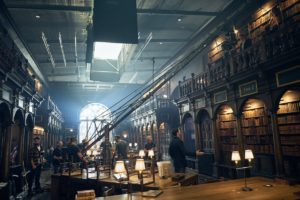
Gaz: In Oxford, the Bodleian is a key example. To be fair to them, they were really keen to be involved and deliver what they could. Once these scripts land, you’ve got witchwind and all sorts of funny things going on, which is flying around the Bodleian … it wasn’t something we could get in and do over a weekend and have control over it. We’d have to go in at night and controlling the lights during the day scenes with those big windows was always going to be an issue. So, as you can all agree, James built an amazing set which we have in our studio in Cardiff and then it was left to us to sort of get into the courtyards of the Bod and various locations again. Those were the sorts of things we dealt with and we’re happy to have worked with the Bodleian, the local councils, the residents and the students to make it work. They were all very interested, very supportive and I think the results speak for themselves.
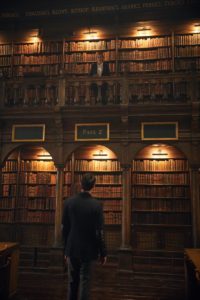
I wasn’t involved as much in Venice, but there’s no way you can cheat that. You have to go there and do it for real to give you that sense of scale and make you feel that you’re there in the middle of it all. I think we were very lucky with weather and all sorts of different things and it really comes across great onscreen. I’m really pleased that we had the confidence to plod on, to make that plan, go big and get big locations and I think it pays off.
The Tenth Knot: We can’t wait to see the reactions of your fans in North America. Is there a particular location that you loved more than anything else in A Discovery of Witches?
Gaz: There’s a really sweet location called Aberglasney Gardens in Carmarthenshire. It’s been on my radar for a while. I did some filming there for a show called Da Vinci’s Demons on the Starz network in America, maybe four, five years ago. I’ve kept it in my pocket since then, not used it for much else. Because of budget constraints when we found out that it (the show) was cancelled, we couldn’t do it all out in Italy, so I had to find something to match. We found the gardens, and those little temples, cloisters, in Aberglasney. So that for me, it’s a really sweet little place, the people are amazing and people should be encouraged to visit.
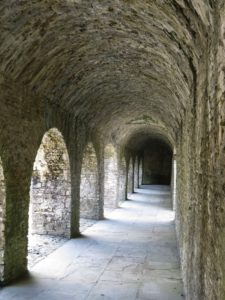
The Tenth Knot: Do you have any other favorite location or locations?
Gaz: Obviously, Aberglasney was really sweet. There was an exterior location that we used for La Pierre, the main location where Diana was held prisoner was in Carew Castle. But the exterior of it we used a different castle which was up on a hill—Carreg Cennen—that is beautiful. We only filmed it with the drone where the drone shot that helicopter stuff when we establish that that’s where Matthew goes to rescue Diana. Nothing much in there, but it’s a real nightmare for us to get into it. You can imagine several people being imprisoned there and nobody’d be the wiser at La Pierre. That location was a real favorite and one I’ve had in my pocket for a long time but hadn’t had a chance to use. I’d been waiting for the right opportunity to use it. That was pretty cool. I was glad I did that.
The Tenth Knot: Can you tell us some of the more entertaining or challenging situations you’ve dealt with while filming?
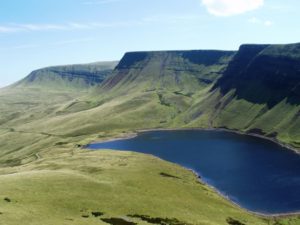
Gaz: Challenging was certainly Episode 2. We were trying to come up with a really dramatic backdrop for Matthew hunting down the stag which should have been up in the Scottish Highlands. We’re not short of dramatic landscapes in Wales. We travelled about 45 minutes north of Cardiff into the Brecon Beacons mountain range which is really beautiful—that wasn’t Scotland—but then of course, I showed JC and James Llyn y Fan Fach, which means the Fabled Lady of the Lake in Carmarthenshire. JC, our director, selected this massive ridge that gives you a fantastic backdrop, so we ended up walking up to it with JC and the rec unit and he loved it at the top.
Now, as I said earlier, it’s a big crew of 150 people, we’re very high in the mountains and I’ve got to get people in and out safely. We took a fair bit of planning for that one. But we ended up having to bring a helicopter in to get some of the equipment up to the top. Most of the crew had to walk. It’s quite an interesting walk up the hill especially when you’re carrying anything. We got a helicopter, we got the worst of the heavy equipment up there. And he was right to push for it because it gives you a real great bit of scale.
It was quite entertaining strapping the stuffed front head of the stag into the helicopter’s front seat and seeing it take off, flying to the top because that’s what we actually used. You already know that that stag was all computer generated, so it was all CG. We used a stag head as reference for Matthew and the rest was created by our amazing digital team. I think it was both challenging and entertaining as we strap a stag’s head into the front seat of a helicopter.
I love showing off Wales!
The Tenth Knot: At what point does the use of CGI enters the conversation and you have to use it and are you reluctant to use CGI?
Gaz: CGI’s a great thing. For me, I love showing off Wales. A lot of people have picked up on how beautiful Wales is and there are amazing locations. But we can do a little bit of everything in Wales because we have these talented people in CG now and various resources. It’s an expensive thing to do and very time-consuming, but you can pretty much use all these landscapes or most buildings in Wales and have them double for any other country. As I said earlier on the show Da Vinci’s Demons, we shot 28 hours of drama set in Renaissance Italy and we shot it all in Wales. We’ve got so much architecture and pockets of everything, just getting our CG artists to extend that a little bit to get us on the right track. I’m very keen to show off Wales and on how these chaps can make it look even better. So I’m not adverse to it at all. We owe quite a bit to our CG friends.
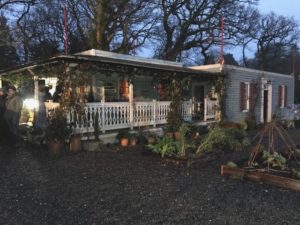
The Tenth Knot: Is the Bishop house a real house?
Gaz: We built the exterior on location, then James built the interior in the studio. We only built the front of the house and we only built a single storey, so that second storey that you see in the opening shots are all CG as well. It was a great, great set, to be fair. It was built where we did for that backdrop of trees and we hit it at the right time in the fall in October. I don’t think you would question that that wasn’t actually Madison County. You guys are the locals but we thought that it worked okay.
The Tenth Knot: Going back to Episode 3, when Matthew takes Diana to his house outside Oxford, there’s a glimpse of a village just beyond when you’re looking out. What’s the name of that village?
Gaz: That village exists, yes. It’s funny. That was a very last-minute request. We were filming in Oxford at the time and needed something relatively close so on the way back just to fit in that schedule. We ended up coming up with a village called Snowshill in Gloucestershire. It wasn’t planned. It was a very last-minute thing to get that aerial shot before we close on them arriving at his property.
A Discovery Of Witches was just a real fun project to do and I’ve decided I’m going to do the second series. I’m looking forward to that and I’m looking forward to the time travel aspects of it. It’ll be getting us back into some contemporary locations as well as period stuff. We’ll be mixing it up next year.
The Tenth Knot: Thank you so, so much for spending time with us.
Gaz: Oh, not at all, It’s lovely talking to you ladies.
Follow Gaz on Twitter or visit his website.
Learn more about Wales at VisitWales.com!
… To be continued.



